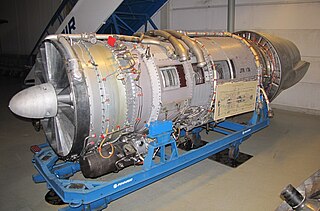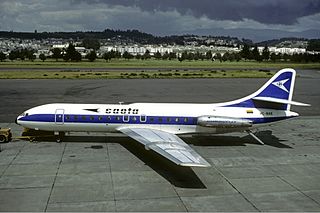
The Sud Aviation SE 210 Caravelle is a French jet airliner produced by Sud Aviation. It was developed by SNCASE in the early 1950s, and made its maiden flight on May 27, 1955. It included some de Havilland designs and components developed for the de Havilland Comet. SNCASE merged into the larger Sud Aviation conglomerate before the aircraft entered revenue service on April 26, 1959, with Scandinavian Airlines System (SAS); 282 were built until production ended in 1972. It was ordered by airlines on every continent and operated until its retirement in 2005.

Indian Airlines was a state-owned airline in India that later became a division of Air India Limited before ultimately ceasing operations. It was based in Delhi and focused primarily on domestic routes, along with several international services to neighbouring countries in Asia and limited flights to the Middle East and South-East Asia. It was a division of Air India Limited after the merger of eight pre-Independence domestic airlines.

On 25 July 2000, Air France Flight 4590, a Concorde passenger jet on an international charter flight from Paris to New York, crashed shortly after takeoff, killing all 109 people on board and four on the ground. It was the only fatal Concorde accident during its 27-year operational history.

The Pratt & Whitney JT8D is a low-bypass turbofan engine introduced by Pratt & Whitney in February 1963 with the inaugural flight of the Boeing 727. It was a modification of the Pratt & Whitney J52 turbojet engine which powered the US Navy A-6 Intruder and A-4 Skyhawk attack aircraft. Eight models comprise the JT8D standard engine family, covering the thrust range from 12,250 to 17,400 pounds-force, and power the 727, 737-100/200, and DC-9. The updated JT8D-200 family, covering the 18,900 to 21,000 pounds-force, powers the MD-80 and re-engined Super 27 aircraft. The JT8D was built under license in Sweden as the Volvo RM8, a redesigned afterburning derivative for the Saab 37 Viggen fighter. Pratt & Whitney also sells static versions for powerplant and ship propulsion as the FT8.
This is a list of aviation-related events from 1976.

Swissair Flight 306, a Sud Aviation SE-210 Caravelle III, named Schaffhausen, was a scheduled international flight from Zürich to Rome, via Geneva. It crashed near Dürrenäsch, Aargau, on 4 September 1963, shortly after take-off, killing all 80 people on board.

A compressor stall is a local disruption of the airflow in the compressor of a gas turbine or turbocharger. A stall that results in the complete disruption of the airflow through the compressor is referred to as a compressor surge. The severity of the phenomenon ranges from a momentary power drop barely registered by the engine instruments to a complete loss of compression in case of a surge, requiring adjustments in the fuel flow to recover normal operation.
Aerosucre S.A. is a cargo airline based in Bogotá, Colombia. It began operation in 1969 and operates scheduled international and domestic cargo services throughout Latin America and the Caribbean. Its home base is El Dorado International Airport, Bogotá. Aerosucre has been involved in a number of accidents and incidents during its lifetime, and more recently, internet videos have emerged showcasing reckless behavior by its pilots.

Pacific Western Airlines Flight 501 was a regularly scheduled flight from Calgary to Edmonton, Alberta, Canada. The aircraft caught fire during takeoff on March 22, 1984. All 119 passengers and crew members survived, but five people suffered serious injuries while 22 others suffered minor injuries.

A turbine engine failure occurs when a turbine engine unexpectedly stops producing power due to a malfunction other than fuel exhaustion. It often applies for aircraft, but other turbine engines can fail, like ground-based turbines used in power plants or combined diesel and gas vessels and vehicles.

As of July 2020, a total of 60 Boeing 747 aircraft, or just under 4% of the total number of 747s built, first flown commercially in 1970, have been involved in accidents and incidents resulting in a hull loss, meaning that the aircraft was either destroyed or damaged beyond economical repair. Of the 60 Boeing 747 aircraft losses, 32 resulted in no loss of life; in one, a hostage was murdered; and in one, a terrorist died. Some of the aircraft that were declared damaged beyond economical repair were older 747s that sustained relatively minor damage. Had these planes been newer, repairing them might have been economically viable, although with the 747's increasing obsolescence, this is becoming less common. Some 747s have been involved in accidents resulting in the highest death toll of any civil aviation accident, the highest death toll of any single airplane accident, and the highest death toll of a midair collision. As with most airliner accidents, the root of cause(s) in these incidents involved a confluence of multiple factors that rarely could be ascribed to flaws with the 747's design or its flying characteristics.

BOAC Flight 712 was a British Overseas Airways Corporation (BOAC) service operated by a Boeing 707-465 from London Heathrow Airport bound for Sydney via Zurich and Singapore. On Monday 8 April 1968, it suffered an engine failure on takeoff that quickly led to a major fire; the engine detached from the aircraft in flight. After the aircraft had made a successful emergency landing, confusion over checklists and distractions from the presence of a check pilot contributed to the deaths of five of the 127 on board. The direct cause of the fire was the failure of a compressor wheel, due to metal fatigue.

Caspian Airlines Flight 7908 was a scheduled commercial flight from Tehran, Iran, to Yerevan, Armenia, that crashed near the village of Jannatabad, outside the city of Qazvin in north-western Iran, on 15 July 2009. All 153 passengers and 15 crew on board died.
Air France has been in operation since 1933. Its aircraft have been involved in a number of major accidents and incidents. The deadliest accident of the airline occurred on June 1, 2009, when Air France Flight 447, an Airbus A330-203, flying from Rio de Janeiro to Paris crashed into the Atlantic Ocean with 228 fatalities. A selected list of the most noteworthy of these events is given below.

Sun Way Flight 4412 was an international scheduled cargo flight from Karachi, Pakistan, to Khartoum, Sudan. On 28 November 2010, the Ilyushin Il-76 operating the flight crashed while attempting to return to Karachi after one of the engines catastrophically failed shortly after take-off. Twelve people were killed in the crash: everyone on board the aircraft and four people on the ground. The engine failure was caused by metal fatigue resulting from operation of the engine beyond its design life.

The 1986 Aerovías Guatemala air crash occurred on 18 January 1986 and involved a Sud Aviation SE-210 Caravelle III that crashed into a hill on approach to Santa Elena Airport, Flores, Guatemala after a short flight from Guatemala City's La Aurora International Airport. All 93 passengers and crew on board were killed, making it the worst air disaster in Guatemalan history.

On 15 March 1974, Sterling Airways Flight 901, a Sud Aviation Caravelle operated by Sterling Airways, experienced a landing gear failure as it was taxiing for take-off. The right main landing gear collapsed, which caused the right wing to contact the runway, rupturing a fuel tank and igniting the spilt fuel. The fire killed 15 passengers and injured 37 passengers and crew. The aircraft had been chartered by tour company Tjæreborg to take tourists around Asia, and was on the way back to Copenhagen when the accident happened. The accident came only two years after the crash of Sterling Airways Flight 296.














